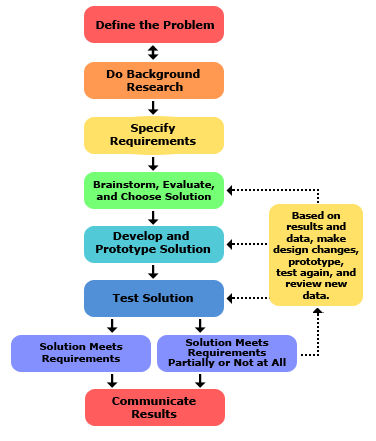Engineering Design Process
What is the Engineering Design Process?
Many times the solution to a problem involves designing a product (like a machine or computer code) that meets certain criteria and/or accomplishes a certain task. This process is different from the Steps of the Scientific Method, which you may be more familiar with. If your project involves making observations and doing experiments, you should probably follow the Scientific Method. If your project involves designing, building, and testing something, you should probably follow the Engineering Design Process. If you still are not sure which process to follow, you should read Comparing the Engineering Design Process and the Scientific Method.
The interactive diagram below may help you understand the engineering design process, and how it is applied to an experiment or project. You can click on parts of the diagram to learn more. Use the "return to top" button  to return to the diagram for more exploration.
to return to the diagram for more exploration.
 Image Credit: created by Amy Cowen for Science Buddies / Science Buddies
Image Credit: created by Amy Cowen for Science Buddies / Science BuddiesThe engineering design process begins by defining a problem and completing background research on the problem. Requirements are specified and a solution is chosen. A prototype of the solution is built and then tested. If the solution built meets the requirements then the results can be shared. If the solution does not meet all the requirements then another solution is thought of and tested. Each iteration should use the data from the previously tried solution to meet all of the initial requirements.
Engineers do not always follow the engineering design process steps in order, one after another. It is very common to design something, test it, find a problem, and then go back to an earlier step to make a modification or change to your design. This way of working is called iteration, and it is likely that your process will do the same!
Steps of the Engineering Design Process
1. Define the Problem
The engineering design process starts when you ask the following questions about problems that you observe:
- What is the problem or need?
- Who has the problem or need?
- Why is it important to solve?
[Who] need(s) [what] because [why].
2. Do Background Research
Learn from the experiences of others — this can help you find out about existing solutions to similar problems, and avoid mistakes that were made in the past. So, for an engineering design project, do background research in two major areas:
- Users or customers
- Existing solutions
3. Specify Requirements
Design requirements state the important characteristics that your solution must meet to succeed. One of the best ways to identify the design requirements for your solution is to analyze the concrete example of a similar, existing product, noting each of its key features.
4. Brainstorm Solutions
There are always many good possibilities for solving design problems. If you focus on just one before looking at the alternatives, it is almost certain that you are overlooking a better solution. Good designers try to generate as many possible solutions as they can.
5. Choose the Best Solution
Look at whether each possible solution meets your design requirements. Some solutions probably meet more requirements than others. Reject solutions that do not meet the requirements.
6. Develop the Solution
Development involves the refinement and improvement of a solution, and it continues throughout the design process, often even after a product ships to customers.
7. Build a Prototype
A prototype is an operating version of a solution. Often it is made with different materials than the final version, and generally it is not as polished. Prototypes are a key step in the development of a final solution, allowing the designer to test how the solution will work.
8. Test and Redesign
The design process involves multiple iterations and redesigns of your final solution. You will likely test your solution, find new problems, make changes, and test new solutions before settling on a final design.
9. Communicate Results
To complete your project, communicate your results to others in a final report and/or a display board. Professional engineers always do the same, thoroughly documenting their solutions so that they can be manufactured and supported.
Try our lesson plans:
- Defining an Engineering Design Problem with Paper Airplanes (Elementary School)
- Teaching Engineering Design with an Egg Drop (Middle School)
Assign a student quiz with Google Classroom:
- Engineering Design Process Quiz (Beginner)
- Engineering Design Process Quiz (Intermediate)





